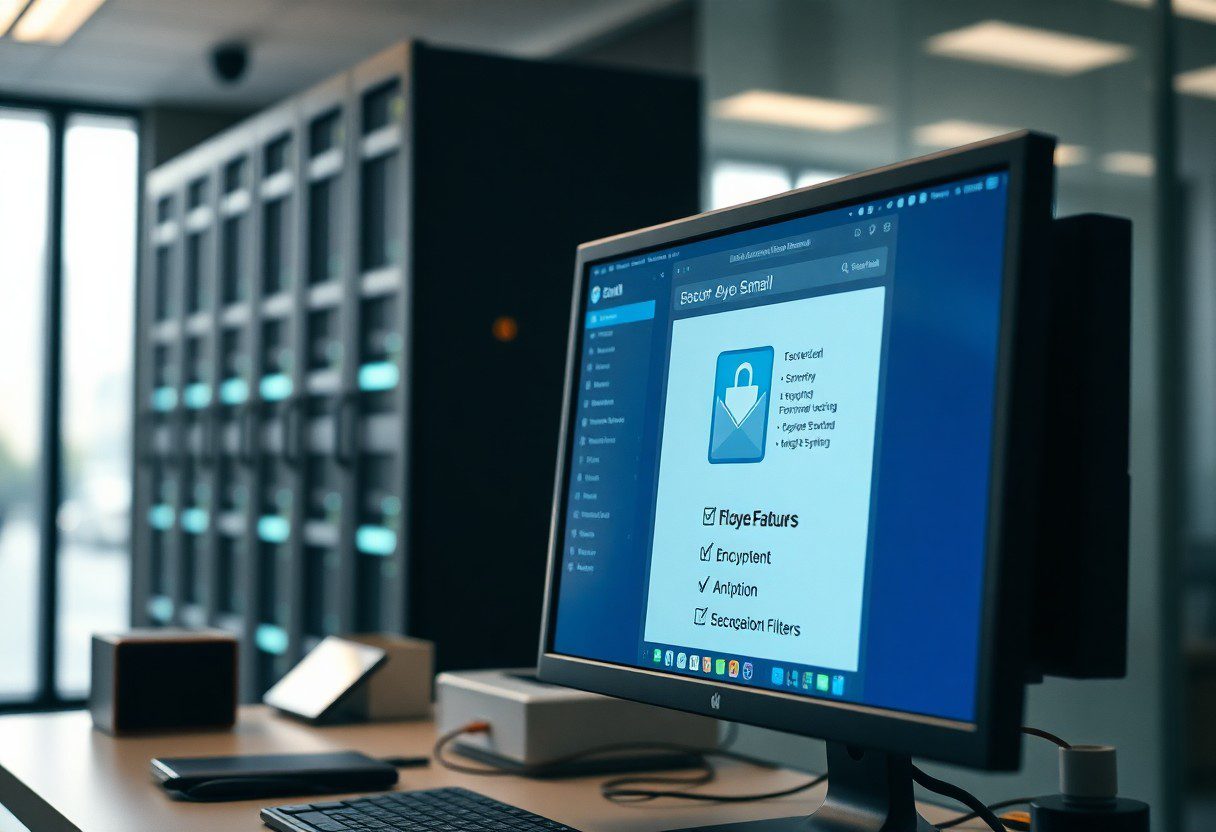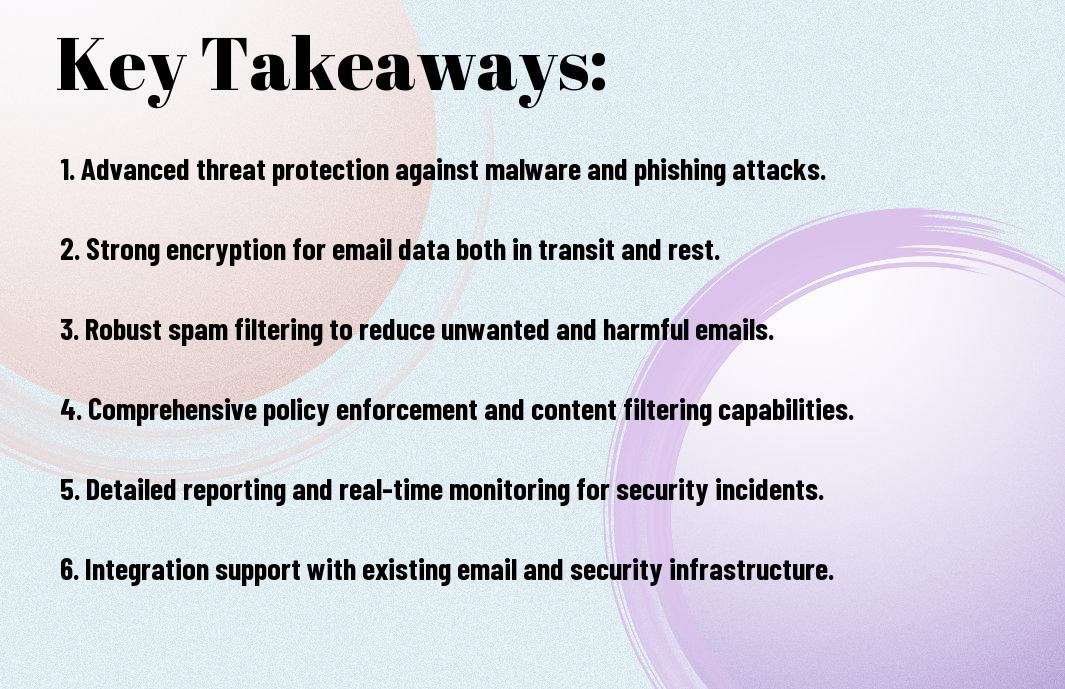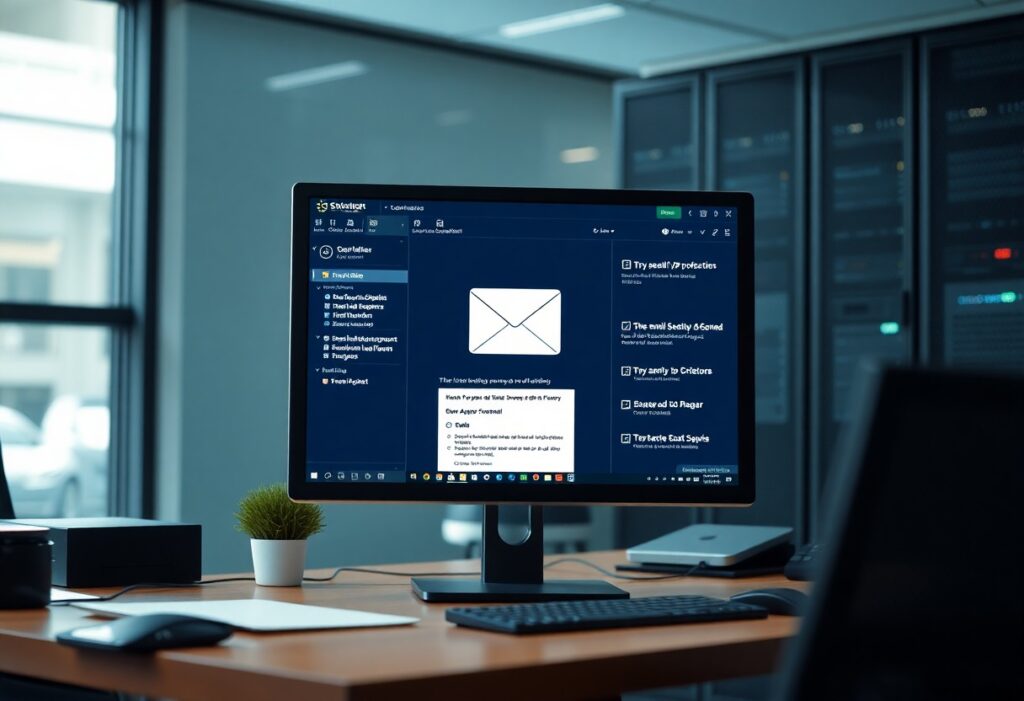Most businesses operate in a digital world where email communication is vital for daily operations, making it vital for you to protect your organization from potential threats. A secure email gateway serves as your first line of defense against spam, phishing, and malware attacks, ensuring both the integrity and confidentiality of your communications. As you evaluate different secure email gateways, you’ll want to focus on key features like advanced threat detection, encryption capabilities, and seamless integration with your existing systems. This guide will help you navigate the critical aspects to consider when selecting the right solution for your needs.

Key Takeaways:
- Effective threat detection and prevention capabilities, including blocking spam, malware, and phishing attempts.
- Robust encryption options to secure sensitive data both in transit and at rest.
- Comprehensive reporting and analytics tools for monitoring email traffic and identifying potential security breaches.
- Integration with existing security infrastructure to enhance overall cybersecurity posture.
- User-friendly management interface that allows for easy configuration and policy enforcement.

The Power of Real-Time Threat Detection
Real-time threat detection acts as your first line of defense against emerging cyber threats, enabling your secure email gateway to identify and neutralize risks before they can compromise your systems. By leveraging innovative technologies, these gateways provide immediate feedback to help you understand and mitigate risks associated with email communications.
How Advanced Algorithms Work
Advanced algorithms drive the efficiency of real-time threat detection by analyzing incoming emails for patterns and anomalies. Machine learning models continuously learn from historical data, enhancing their accuracy over time.
- Analyzing subject lines and content for suspicious keywords
- Scanning attachments for known malware signatures
- Monitoring sender reputation to identify potential spoofing
- Identifying unusual user behavior through activity patterns
| Feature | Description |
|---|---|
| Content Analysis | Scans email content for phishing scams and malware links. |
| Real-time Alerts | Provides immediate notification when threats are detected. |
| User Behavior Tracking | Monitors user activity to spot potential breaches. |
Importance of Behavioral Analysis
Behavioral analysis deepens your threat detection capabilities by focusing on the typical patterns of email usage. This method flags any deviations from established norms, making it easier to spot insider threats or compromised accounts.
Incorporating behavioral analysis equips your secure email gateway with the ability to adapt to your unique environment. For instance, if an employee suddenly sends large volumes of emails to unfamiliar addresses, behavioral analysis can trigger alerts for further investigation. By distinguishing normal patterns from potential threats, this approach enhances your overall security posture and protects critical business data more effectively, allowing you to respond swiftly to anomalies without relying solely on static filters or outdated heuristics.

Robust Encryption Mechanisms: Safeguarding Your Communication
In an era where data breaches and privacy concerns are rampant, robust encryption mechanisms are vital for securing your email communications. A secure email gateway should employ advanced encryption protocols such as TLS (Transport Layer Security) and PGP (Pretty Good Privacy) to ensure that your sensitive information is protected from unauthorized access both during transmission and at rest. This not only enhances confidentiality but also bolsters your trustworthiness in professional communications.
End-to-End vs. In-Transit Encryption
Understanding the difference between end-to-end and in-transit encryption is key to choosing a secure email gateway. In-transit encryption protects your emails while they are being transmitted over the internet, shielding them from interception. However, end-to-end encryption ensures that only the intended recipients can read the messages, with their content being encrypted from the moment it leaves your device until it arrives at the recipient’s device, providing an additional layer of security.
Key Management and User Control
Effective key management is necessary to maintaining the integrity of your encrypted communications. With a secure email gateway, you should have the ability to manage encryption keys, giving you control over who can access your sensitive information. This involves setting permissions, revoking access when necessary, and generating new keys as needed to ensure ongoing security. A solid key management system allows you to balance usability and security without compromising data protection.
Implementing a structured key management solution enhances your email security posture significantly. It enables you to designate specific users who can decrypt messages, preventing unauthorized access even if the encryption keys were somehow compromised. Furthermore, regular rotation of keys can minimize long-term exposure from potential leaks. It’s advisable to utilize solutions that offer automated key lifecycle management, simplifying the process while ensuring compliance with data protection regulations. Well-organized key management not only protects your communications but also builds trust with your clientele.
Granular Policy Enforcement: Tailoring Security to Your Needs
Granular policy enforcement allows you to customize security measures based on your organization’s unique needs. This feature enables precise control over email filtering, access levels, and threat responses, ensuring that your policies align with risk tolerance and compliance requirements. By implementing granular controls, you can adapt your security posture not just for the organization as a whole but also for specific departments or user roles.
Customizable Rules for Different User Groups
Establishing customizable rules means you can implement distinct security protocols for various teams or roles within your organization. For instance, your finance department might require stricter controls due to handling sensitive financial data, while more lenient rules could be appropriate for marketing teams focused on outreach. This tailored approach enhances protection without hindering productivity.
Risk-Based Policy Adjustments
Adjusting policies based on identified risks ensures that your security measures remain effective against evolving threats. You can analyze historical data and current threat landscapes to refine user access, email filtering levels, and response times. Consequently, users exposed to higher risks might face stricter scrutiny, while others operating in lower-risk environments benefit from fewer restrictions.
Risk-based policy adjustments rely on continuous monitoring and the analysis of threat intelligence feeds. When a new vulnerability or attack vector emerges, your secure email gateway can automatically alter policies for those most affected by the change. For example, if a specific phishing scheme targets suppliers in your industry, enhanced scanning for emails from those vendors can be enacted to mitigate risk while keeping overall operations seamless. This proactive approach emphasizes resilience without compromising efficiency.
Seamless Integration with Existing Infrastructure
A secure email gateway should effortlessly integrate into your existing IT environment, minimizing disruptions while enhancing your security posture. This means compatibility with various email servers, such as Microsoft Exchange and G Suite, as well as collaboration tools like Slack or Teams. Opt for a gateway that can be quickly incorporated into your current systems without requiring extensive modification or additional resources, allowing you to maintain your operational efficiency while elevating email security.
Compatibility with Other Security Tools
Your secure email gateway should work cohesively with other security tools already in your organization, such as firewalls, endpoint protection, or data loss prevention (DLP) solutions. Seamless interoperability enhances your security framework by ensuring that threat intelligence can be shared across platforms. A gateway that plays well with these tools can strengthen your defense against sophisticated email-based attacks.
Simplifying Deployment and User Adoption
Choosing a secure email gateway that simplifies deployment can significantly reduce the burden on your IT team and facilitate quicker user adoption. An intuitive interface for both administrators and end-users can promote efficient onboarding. Look for solutions that offer pre-configured settings or guided setups to streamline the integration process while ensuring that your security policies are enforced right from the outset.
Simplifying deployment and user adoption is crucial for getting the most out of your secure email gateway. Solutions that provide comprehensive training materials, alongside responsive customer support, can help bridge any knowledge gaps for your team members. Additionally, a gradual rollout, featuring pilot programs or phased implementation, can ease the transition, allowing users to familiarize themselves with new protocols without disrupting daily operations. The more user-friendly your gateway, the more likely your employees will embrace and adhere to the new security measures. This not only enhances compliance but directly reinforces your organization’s overall security framework.
Comprehensive Reporting and Analytics
Comprehensive reporting and analytics functionality enhances your understanding of the security landscape affecting your email communication. These features allow you to visualize threats, track user behavior, and monitor the effectiveness of your security measures. With access to detailed logs and customizable dashboards, you can quickly assess vulnerabilities and adjust strategies to strengthen your defenses against emerging threats.
Insights for Informed Decision-Making
Insights derived from reporting and analytics enable you to make strategic decisions about your email security posture. By analyzing trends and patterns, such as the types of threats your organization faces, you can implement targeted training and awareness programs. These insights help tailor your security approach based on actual data, leading to more resilient practices that protect your organization.
Metrics that Matter: What to Track
Focusing on key metrics can help you refine your email security strategies effectively. Track data points such as the number of blocked threats, user engagement levels with potential phishing emails, and response times to security incidents. These metrics not only showcase how your system is performing but also highlight areas needing improvement, allowing you to proactively address weaknesses.
Some of the most significant metrics to monitor include the volume of spam and phishing attempts intercepted, the average time taken to identify and mitigate threats, and user awareness levels based on their interactions with flagged emails. For a comprehensive view, consider tracking incident response times and the rate of false positives, as these can inform your team’s overall efficiency and effectiveness in addressing security challenges. By honing in on these metrics, you not only strengthen your email gateway but also cultivate a culture of security awareness within your organization.
Conclusion
Considering all points, when selecting a secure email gateway, you should prioritize features such as advanced threat detection, data loss prevention, encryption capabilities, and user-friendly management interfaces. Additionally, look for customization options that align with your specific security policies, as well as reliable customer support to assist with any issues that may arise. By focusing on these key features, you can better protect your email communications from evolving cyber threats and ensure the safety of your sensitive information.
FAQ
Q: What is a secure email gateway and why is it important?
A: A secure email gateway is a security solution designed to monitor and filter inbound and outbound email traffic for an organization. It protects against threats such as phishing, malware, and spam while also ensuring compliance with various data protection regulations. Its importance lies in safeguarding sensitive information and maintaining the integrity of communication channels within a business.
Q: What specific threats should a secure email gateway protect against?
A: A secure email gateway should safeguard against a variety of threats, including phishing attacks, ransomware, malware, and spam. Additionally, it should have features to block email-based data leaks and ensure that emails are not subject to impersonation attacks. Effective protection against these threats is imperative for maintaining the security of an organization’s data and communications.
Q: How does email encryption feature into secure email gateways?
A: Email encryption is a critical feature of secure email gateways. It ensures that sensitive information is protected during transit by converting the email content into a coded format that can only be accessed by authorized recipients. This feature not only enhances security but also helps in compliance with data protection regulations by safeguarding personal and sensitive information from unauthorized access.
Q: What level of integration should a secure email gateway offer?
A: A secure email gateway should offer seamless integration with existing security solutions and email systems, such as Microsoft 365 or Google Workspace. This integration enables centralized management of security policies and enhances the overall security posture of the organization. The ability to work with other cybersecurity tools, like endpoint protection and SIEM systems, can provide comprehensive security across various platforms.
Q: What reporting and analytics features are beneficial in a secure email gateway?
A: Reporting and analytics features are vital in a secure email gateway as they provide insights into email traffic patterns, threat detection, and overall security performance. Detailed reports on blocked threats, user behavior, and compliance metrics help organizations identify vulnerabilities and make informed decisions about their email security strategies. Real-time alerts can also enhance responsiveness to potential security incidents.

